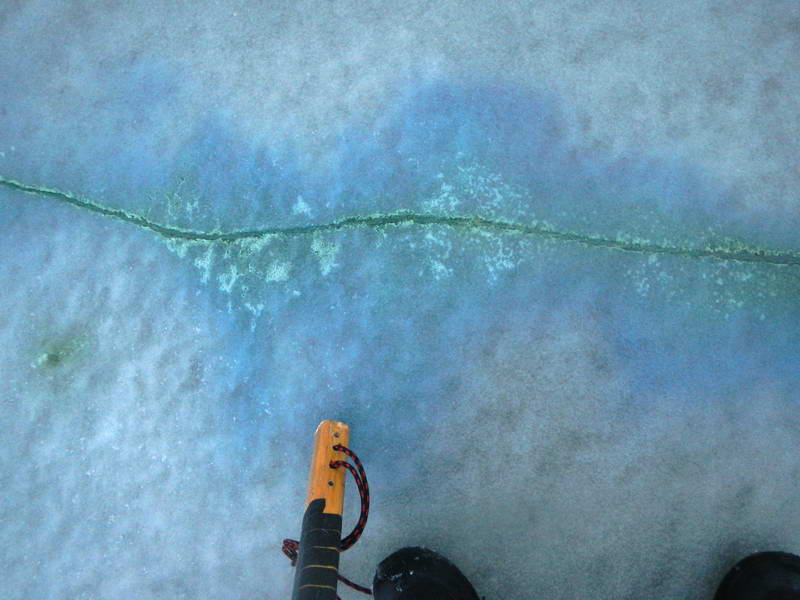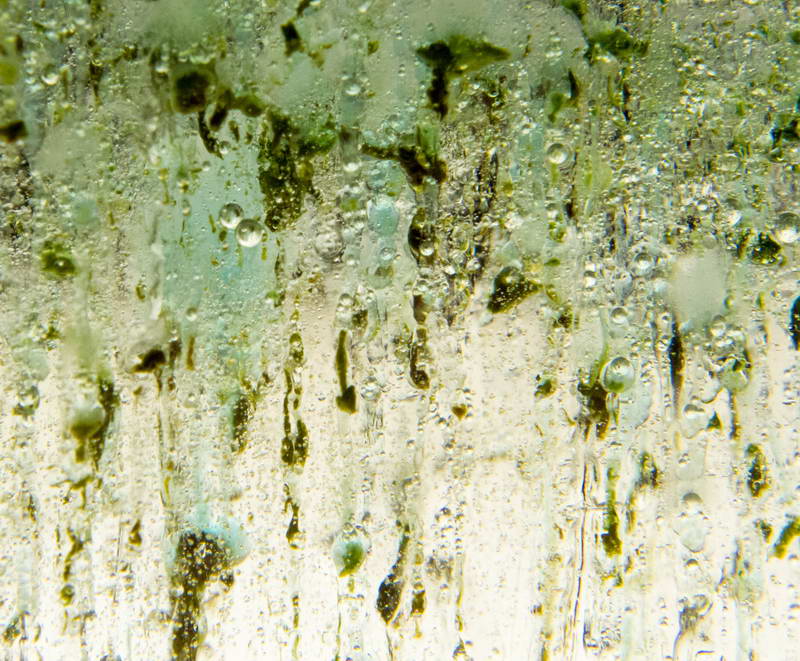Blue Ice
 Saturday, December 7, 2013 at 08:26PM
Saturday, December 7, 2013 at 08:26PM We had some spectacular colors on one of our local ponds this past week.

An explanation of the above picture from top to bottom:
- The dark stuff is 3 day old (Nov 29) black ice at the edge of a frozen new-ice hole
- The green band is bio-skuz (my term) that accumulated on the down wind end of the hole before it froze. The pond is heavily infested with aquatic plants.
- The white stuff is a 1/4" layer of snow ice that fell as snow 5 days ago (Nov 27) on black ice that came in 7 days ago (Nov 25).
- The blue is (as explained below) pigments from cyanobacteria that have died and released their blue pigments into the water. They are soluble in water and were carried by the water as it infiltrated the snow while it fell 5 days ago.
- The black object at the bottom is the front third of my shoe (for scale).
- Note: The picture was taken on December 2, 2013
A friend, Tom Vogelmann, is a botanist with consideragle expertise in photosynthesis who has also studied algae in snow. I sent him the above picture with my speculation on what might be going on. His comments:
That's a great photo and I have never seen this phenomenon in the wild. But of course I don't hang out at the edge of developing ice sheets either. The blue is most certainly pigment from cyanobacterial cells that have been broken apart by freezing. Most cyanobacteria contain two intensely blue pigments, phycocyanin and allophycocyanin. Sometimes they contain a third pink pigment called phycoerythrin. They are all proteins that are closely associated with the photosynthetic membranes and their role is to capture light at wavelengths that are weakly absorbed by chlorophyll, and transfer the energy to chlorophyll via resonance transfer (99% efficiency). These pigments, when released from the cells, are also highly fluorescent so if you have a hand-held UV lamp, you can make them light up. Fun stuff.
In a follow up conversation I asked Tom about how the blue pigment could get out of the cells other than by freezing as it seems unlikely that the 'ice edge bio-skuz' froze before the pigment became mixed with pond water which was then wicked into the snow that fell on the 27th. He pointed out that abrasion by wave jostled snow/ice chunks mixed with the cyanobacteria might be sufficient. Another possibility is the cyanobacteria may die at above freezing temperatures if the lipids in the membranes get too stiff (he use the example of a banana turning black in the refrigerator).
A third possibility is that cell death occurred before accumulation at the ice edge and the ice edge jostling broke up the dead cells to release the pigments.
 Blue stain in snow ice around a wave-break crack about 40 feet from a frozen ice edge in the older ice.
Blue stain in snow ice around a wave-break crack about 40 feet from a frozen ice edge in the older ice.
 Looking along another crack about 100 ft from the frozen ice edge.
Looking along another crack about 100 ft from the frozen ice edge.

This photo is looking through a 1" thick vertical section cut out of the green band. It is illuminated by a light table underneath the ice block. The dark green items are plant bits. On the tops of some of them the bluish pigments appear to have made their way upward through the pore structure that existed when the ice was thawed ( 11/27or 12/6). The image is about an inch wide.
We had a windy warm spell after these pictures were taken and the snow ice layer was zambonied off the ice sheet.
Bob
 robertdill | Comments Off |
robertdill | Comments Off | 
